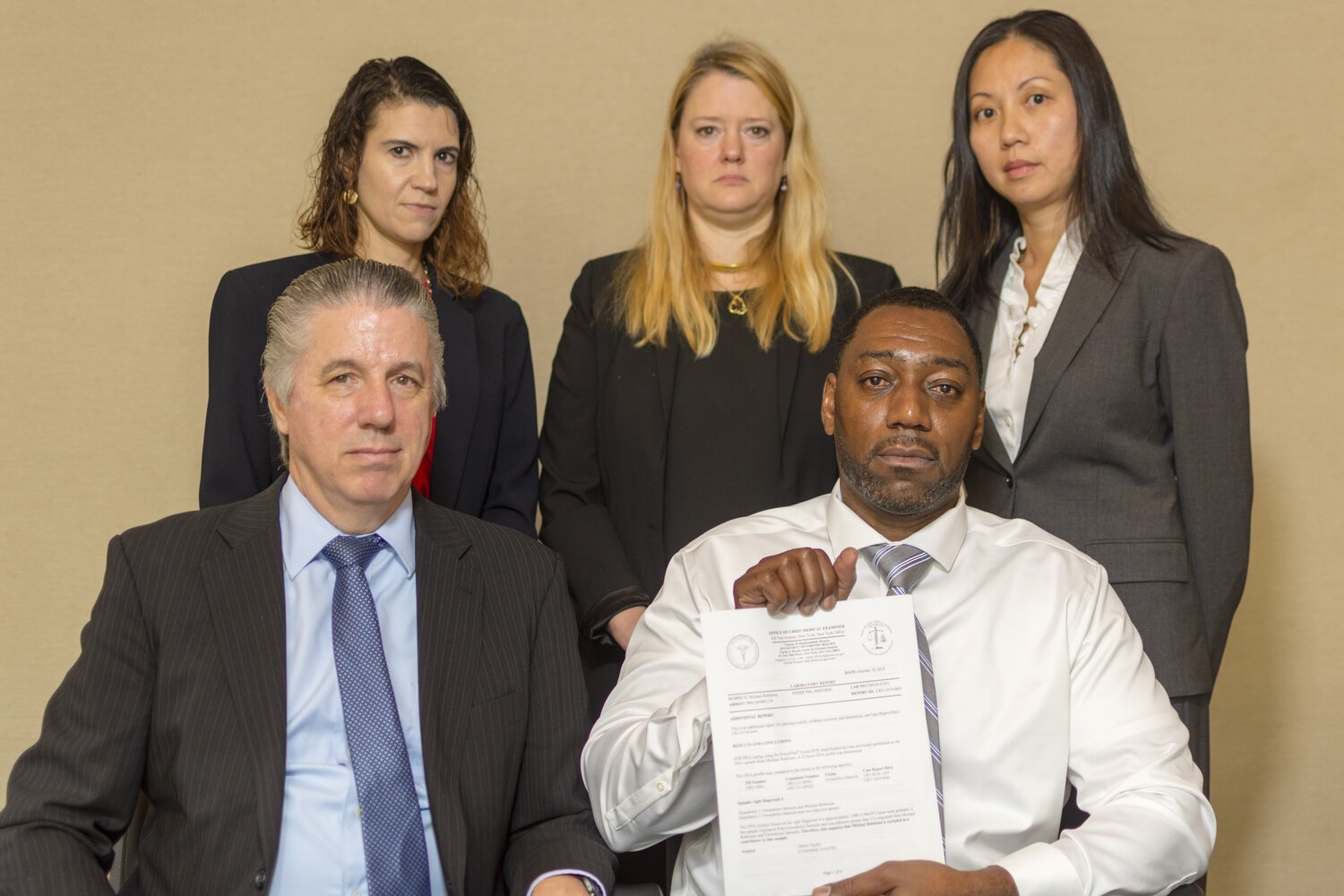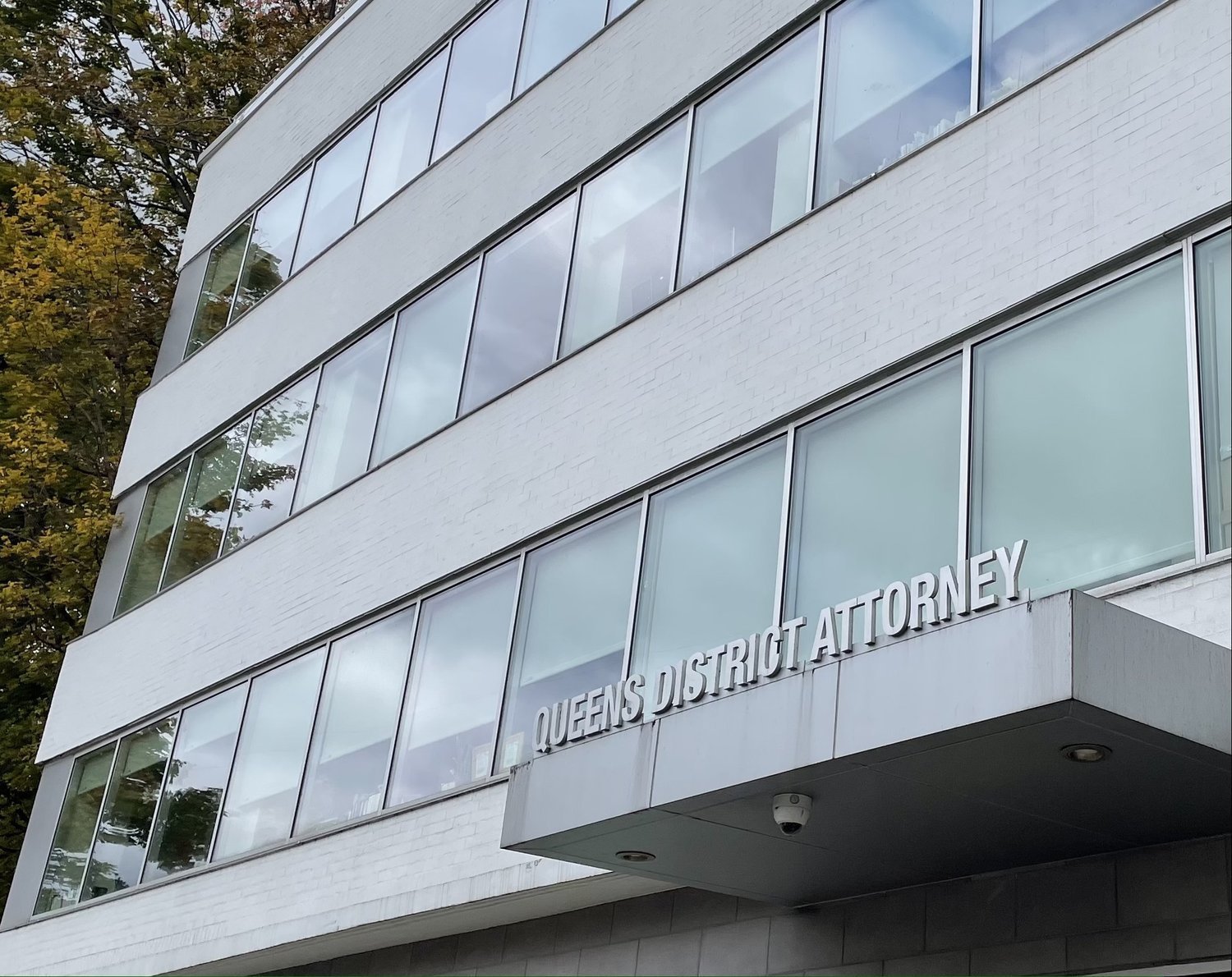Despite wrongful conviction ruling, Queens DA refuses to drop 30-year-old murder case
/Front row, left to right: Legal Aid Criminal Appeals Bureau attorney Harold Ferguson and Michael Robinson. Back row, left to right: Legal Aid DNA Unit attorneys Terri Rosenblatt, Jessica Goldthwaite and Jenny Cheung. File photo via Legal Aid Society
By Jacob Kaye
The Queens district attorney is continuing to pursue a case against a Queens man who was recently found by an appellate court to have been wrongfully convicted of the 1993 murder of his estranged wife.
In March, a four-judge panel in the Appellate Division, Second Department overturned Michael Robinson’s 30-year-old murder conviction – for which he served a quarter of a century in prison – and kicked the case back to Queens Criminal Court, giving Queens District Attorney Melinda Katz and her prosecutors the option to either retry the case or formally dismiss the charges against Robinson, who has long maintained his innocence.
Around two months after the decision was issued, the Queens district attorney’s office made their decision.
Despite the judges’ ruling, Robinson’s claims of innocence, his completed sentence and newly-discovered DNA evidence that suggests it was 78 trillion times more likely that someone other than Robinson stabbed Gwendolyn Samuels to death in 1993, the Queens DA is attempting to reverse the appellate court’s decision and get the case kicked up to the Court of Appeals, the state’s top court.
“We are applying to the Court of Appeals for permission to appeal the Appellate Division's decision to reverse the defendant’s conviction,” a spokesperson for the Queens district attorney said in a brief statement when asked about the case by the Eagle this week.
For Robinson, the DA’s decision to continue to pursue the case has kept him in a state of limbo. He’s been unable to fully restart his life since being released by a parole board from prison in 2019.
“The district attorney's office has every right to appeal,” Robison told the Eagle. “But although I've been exonerated, I won't truly be fully vindicated until this is finally over.”
Throughout the legal saga, Robinson and his family say they’ve tempered their expectations every time there appears to be a chance that the former correctional officer’s name will be cleared. But that didn’t make it any less painful when the learned the DA’s office wasn’t ready to drop the case.
“It's been so long and for them to continue to pursue the case in light of the decision that the appellate court came down with, along with the results from the DNA test – it’s just baffling,” he added. “We're just going to continue to hold on.”
In their application to the top court, written by Queens Assistant District Attorney William Branigan, the DA’s office argued that the appellate court didn’t have the authority to make a ruling in Robinson’s case, and that its assessment of the newly-discovered DNA evidence was wrong.
It’s not the first time they’ve fought against the validity of the DNA evidence and its inclusion in the case. The DNA was found under the victim’s fingernails, and only came to light after Robison filed a Freedom of Information Law request, got it tested and engaged in a lengthy legal battle to get a judge to consider it.
The Queens district attorney’s office has applied to have the Court of Appeals overturn and Appellate Division decision that found that a Queens man was wrongfully convicted of a 1993 murder. Eagle file photo by Jacob Kaye
The DA’s office argued that because Samuels died of stab wounds to her back, it’s unclear how the DNA of the killer would have made its way under her fingernails.
In Branigan’s application to the Court of Appeals, he argued that by reviewing the case, the top court will have the opportunity to consider a number of issues with DNA evidence in criminal cases, including how conclusive the evidence needs to be in order to overturn a conviction.
But Harold Ferguson, the staff attorney with the Criminal Appeals Bureau at The Legal Aid Society who represents Robinson, said that beyond the fact that he believes the case doesn’t warrant review by the Court of Appeals, he feels that the Queens DA’s office has applied its own uneven standard to DNA evidence.
“They really take the position that when DNA is inculpatory, it is definitive proof of guilt, but when it is exculpatory, it's meaningless,” Ferguson told the Eagle. “They see DNA as a sword, but never as a shield.”
The same month that they filed the application for appeal, the Queens DA’s office indicted a 58-year-old man in the cold case 1992 murder of a 15-year-old girl in Far Rockaway. The man, who lived in the same building as the girl and shared a bathroom with her family and others, was indicted using newly-uncovered DNA evidence found under the 15-year-old’s preserved fingernail clippings.
“This was definitive proof of guilt and therefore could not have been incidental, and now, in Michael’s case, they take the exact opposite position,” Ferguson said. “Be consistent.”
The DA’s application is being reviewed by Court of Appeals Judge Shirely Troutman, who was appointed to the bench by Governor Kathy Hochul in 2022, and who is considered one of the more liberal-leaning judges on a court that recently found itself under new, more criminal justice-minded management.
But getting a criminal case to the Court of Appeals has proven difficult over the past several years.
During the tenure of Chief Judge Janet DiFiore, who abruptly retired in August of last year and was replaced by Chief Judge Rowan Wilson in April, the Court of Appeals heard a small number of criminal appeals – in addition to fewer cases, in general.
According to reporting by New York Focus, the Court of Appeals averaged 49 criminal decisions a year from 2017 through 2021 – that’s the fewest in any five year average over the past 35 years. The number of criminal cases ruled on by the court hit an all-time low in 2020, when it issued decisions in just 42 cases.
And though Wilson, who has a civil rights and public defense background, has vowed to increase the number of cases the court hears, the DA still likely faces an uphill battle in getting Robinson’s case before the seven judges.
“It is a high bar to get to the Court of Appeals,” Ferguson said.
If the Court of Appeals does decide to take the case, it likely won’t be until at least the fall – the court does not return to session until September.
The wait will likely be a long one for Robinson, who last appeared in Queens Criminal Court on April 11. That was when the Queens district attorney’s office was supposed to decide how they wanted to proceed in the case. Instead, prosecutors told Queens Criminal Court Judge Stephen Knopf that they weren’t ready, and the case was adjourned until June 6. In the light of the request to the Court of Appeals, that appearance has been canceled.
But if Robinson has had to do anything throughout the life of the case, it’s wait.
Michael Robinson (center) with several of his Legal Aid Society attorneys, family and friends in front of the Queens Criminal Courthouse on April 11, 2023. Eagle file photo by Jacob Kaye
While incarcerated, he spent decades attempting to prove his innocence through various means. He says he spent countless hours in the prison’s law library and tried to get his case reviewed by both state and federal courts. All of his attempts failed.
It took him three tries to get a parole board to grant him release, which came in 2019. That’s when his fight to get the conviction overturned was renewed.
Acting without a lawyer, Robinson sought post-conviction DNA testing on blood samples and blood stains that had been discovered through a FOIL request he had made in 2013. A judge rejected the motion without holding a hearing.
Robinson then obtained representation from the Legal Aid Society, which successfully appealed the case to the Appellate Division, Second Department, which sent the case back to the lower Queens court “for further proceedings to ascertain whether the subject DNA evidence exists and, if it does, for forensic DNA testing of that evidence.”
Another roadblock emerged – Robinson and his attorneys were told that the evidence they were looking for was no longer was usable. It had been damaged when the building it was being held in sustained flooding during Hurricane Sandy, they were told.
What followed was a series of hearings to determine whether or not the damaged evidence could still be tested safely and produce a reliable result. In the end, a judge ruled that the testing could go forward.
That’s when the Queens district attorney’s office informed the court that the evidence was not in the flooded facility. It was instead with the office of the chief medical examiner.
“We wasted two years on two hearings, based on a false premise,” Ferguson told the Eagle in March.
The medical examiner then tested the evidence, finding that there was male DNA in the victim’s fingernail scrape. They then tested it against Robinson’s DNA and determined that it wasn’t conclusive enough to support overturning the conviction.
Robinson and Ferguson then got Cybergenetics, a private lab, to review the evidence. Their findings were far more conclusive.
The lab determined that the DNA suggested that it was 78 trillion times more likely that Robinson was not the killer, a finding the office of the chief medical examiner, which conducted further testing, later agreed with. But prosecutors were still not on board, and said that they believed that the male DNA found under Samuels’ fingernails didn’t necessarily come from the murderer, Ferguson said.
Knopf later denied Robinson’s motion to vacate his conviction. His decision was then overturned by the Appellate Division, Second Department.
Through the ups and downs of the case, Robinson’s outlook has mostly remained the same.
“After so many years…there's nothing we can do but wait,” Robinson said.






